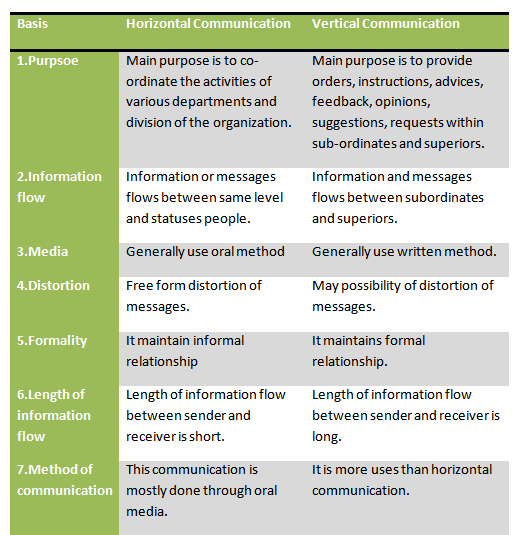The term lateral communication can be used interchangeably as horizontal communication. Horizontal communication is communication among people at the parallel or same level, position, rank or status people of the organization. Horizontal communication is the communication that flows laterally within the organization, involves persons at the same level of the organization. Horizontal communication normally involves coordinating information and allows people with the same or similar rank in an organization to cooperate or collaborate. Some definitions of horizontal communication are as follows:
Ricky W. Griffin, “Horizontal communication involves colleagues and peers at the same level of the organization.”
Bartol and Martin, “Horizontal communication is lateral or diagonal message exchange either within work –unit boundaries, involving peers who report to the same supervisor or across-work unit boundaries, involving individuals who report to different supervisors.”
According to William A. Conboy, “Horizontal communication is the exchanges between and among agencies and personnel on the same level of the organizational chart.”
According to Bovee and others, “Horizontal communication is the flow of information across departmetal boundaries, either laterally or diagonally.”
According to Ivancevich and others, “Horizontal communication occurs when the communicator and the receiver are at the same level in the organization.”
The graphical presentation of horizontal communication is as follows:

So, Horizontal communication is the communication where information or messages flows among the similar or same level statuses of people in the organizational structure.
Differences between horizontal and vertical communication
Horizontal communication is the communication where information or messages flows between the parallel same level or statuses people of the organizational structure. On the other hand, vertical communication is the communication where information or messages flows between or among the subordinates and superiors of the organizational. The difference between horizontal and vertical communication are as follows:

Essentials of effective Horizontal communication
The essentials of effective Horizontal communication are as follows:
(i) Recognition
To make Horizontal communication effective top executive must recognize it is a realistic and useful way to exchange a message.
(ii) Emergency communication
To make it effective this communication system is to be considered a form of emergency communication to effect a quick resolution of a particular problem.
(iii) Direct supervision
To make more effective of this system manager should convince the workers.
(iv) Discipline
To make more effective discipline to be maintained strictly in every level. Otherwise, management may be broken.
(v) Clear understandability
To make effective, care should be taken so that managers may have a clear understanding that horizontal communication is a functional part of the total communication process.
(vi) Interdepartmental communication increase
To make it effective, organizational structure should be made in such a way that opportunity for interdepartmental communication can be ensured.
(vii) Act as Lubricant
To make effective, departments must be developed, so that it will act as a lubricant in the way of effectively using horizontal communication.
One thought on “Horizontal Communication”